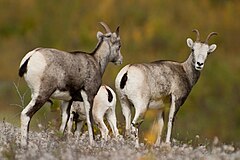Goat antelope
| Caprinae Temporal range: Late Miocene–Recent |
|
|---|---|
 |
|
| Stone sheep (Ovis dalli stonei) in British Columbia, 2009 | |
| Scientific classification | |
| Kingdom: | Animalia |
| Phylum: | Chordata |
| Class: | Mammalia |
| Order: | Artiodactyla |
| Family: | Bovidae |
| Subfamily: |
Caprinae Gray, 1821 |
| Genera | |
|
Nemorhaedus |
|
Nemorhaedus
Rupicapra
Oreamnos
Budorcas
Ovibos
Hemitragus
Ammotragus
Pseudois
Capra
Ovis
and see text
Subfamily Caprinae is part of the ruminant family Bovidae, consisting of mostly medium-sized bovids. A member of this subfamily is called a caprine. A member is also sometimes referred to as a goat-antelope, however, this term "goat-antelope" does not mean that these animals are true antelopes: a true antelope is a bovid with a cervid-like or antilocaprid-like morphology.
Within this subfamily Caprinae, a prominent tribe Caprini includes sheep, goat, and ibex.
Some earlier taxonomies considered Caprinae a separate family called Capridae (whence a caprid), but now it is usually considered a subfamily within the Bovidae family, whence a caprine is a kind of bovid.
Although most goat-antelopes are gregarious and have fairly stocky builds, they diverge in many other ways – the muskox (Ovibos moschatus) is adapted to the extreme cold of the tundra; the Rocky Mountain goat (Oreamnos americanus) of North America is specialised for very rugged terrain; the urial (Ovis orientalis) occupies a largely infertile area from Kashmir to Iran, including much desert country. The European mouflon (Ovis musimon) is thought to be the ancestor of the modern domestic sheep (Ovis aries).
...
Wikipedia
